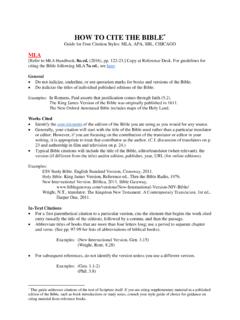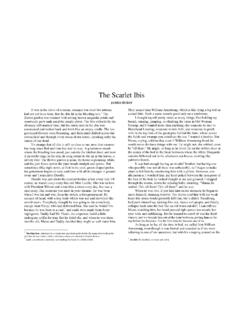Transcription of CHALLENGE CARDS - James Dyson Foundation
1 CHALLENGE CARDS44 engineering and science challenges from the engineers at note that the activities contained here in are intended for children ages seven and above. Adult supervision is recommended for all MANY CAN YOU COMPLETE? Tick the box once you ve completed the SCARED PEPPER11 INERTIAL EGGS05 LIQUID DENSITIES21 COLOURED CARNATIONS15 FLOATING PAPER CLIP09 BRIGHT AS A NEW PENNY03 FLOATING PING-PONG BALLS19 HOW TO MAKE A L AVA L A MP13 MEASURE THE SPEED OF LIGHT07 TORNADO IN A BOTTLE01 CHANGING STATES22 INVISIBLE INK22 ATTR ACTIVE NAILS16 BUILD A COMPASS10 CARTESIAN DIVER04 STRONG AS A DRINKING STR AW20 POTATO POWER14 METAL ETCHING08 CARDBOARD CHAIR02 MARBLE RUN18 BURNING CUSTARD12 DESIGN AND BUILD A HELICOPTER06 COTTON REEL TANK21 MAKE A PERISCOPE15 JELLY AND OIL09 BOAT POWERED BY A CHEMICAL REACTION03 SPAGHETTI BRIDGES19 HOMEMADE WATER BOMB13 WATER CLOCK07 CARDBOARD BOAT01 GEODESIC DOMES17 A TOUGH NUT TO CRACK11 BALLOON CAR RACE05 ELECTRIC MOTOR16 FIRE EXTINGUISHER10 LENZ S
2 LAW04 BALLOON KEBABS20 IVORY SOAP14 WEATHER BALLOON08 NON-NEWTONIAN FLUID02 UNDERWATER VOLCANO18 DANCING RAISINS12 100 + 100 = 192?06 EXPANDING GASESSCIENCE CHALLENGES ENGINEERING CHALLENGES CHANGING STATES 01 SCIENCE CHALLENGEThe briefMake an egg fit into a bottle without breaking it. The method1. Submerge the egg in a glass of vinegar for two days: the shell will become Heat the bottle in hot water remember to use gloves or a tea towel when handling Rest the egg on the neck of the As the air inside the bottle cools down, it will contract and suck the egg down. Top tipTry lubricating the egg with cooking oil or washing up liquid. Designed by Charles, Design engineer at DysonMaterialsAn uncooked eggA pan of boiling water (with adult supervision)A glass of vinegarA wide-mouthed glass bottleHow does it work?
3 Eggs are rich in protein. When heat is applied, chemical bonds within the protein molecules are broken, and new bonds are formed between adjacent molecules. This creates a network of inter-connected proteins which causes the egg to go hard. Vinegar contains acetic acid (CH3 COOH) that dissolves the calcium carbonate (CaCO3) shell but leaves behind the egg s springy +H2 OCO2+H2 OCO2+H2 OCO2+H2O(CH3 COO)2 CaBeforeAfterSCIENCE CHALLENGE01 CHANGING STATESUNDERWATER VOLCANO02 SCIENCE CHALLENGEThe briefCreate a colourful underwater method1. Cut a two foot length of string with a pair of scissors. Tie a knot around the neck of a salt shaker with one end of the string. Double-knot it to ensure the knot is secure. Repeat this process with the other end of the string, resulting in a handle to lower your shaker.
4 2. Empty and clean a large jar. Fill the clean jar about three quarters full with cold Fill the salt shaker with hot water (with adult supervision) as hot as you can get from your tap to just below the neck. Add three to four drops of red food Hold your salt shaker over the mouth of the jar by the string handle. Slowly lower the salt shaker into the jar until the shaker is completely submerged and resting upright on the bottom of the jar. Observe how the coloured water erupts from the shaker into the cold does it work?This shows how convection currents work. A convection current is the way that heat rises and falls in liquids and by Ian,Design engineer at DysonHot air balloons use convection currents. As hot air rises, so too does the iconsUNDERWATER VOLCANO02 MaterialsStringScissors (with adult supervision)An empty salt shakerA large jarFood colouringSCIENCE CHALLENGEFLOATING PING-PONG BALLS03 SCIENCE CHALLENGEThe briefMake two ping-pong balls float in the air flow of a hair dryer at the same time, without hitting each method1.
5 Switch on your hairdryer, making sure it is on the cool setting. 2. Hold it with the nozzle pointing upwards. 3. Place one of the ping-pong balls into the stream of air. 4. Try and place another ball into the same stream of air on top of the first does it work?The hair dryer produces a high velocity stream of air with low pressure. The surrounding air is at a higher pressure which keeps the ball inside the stream. When the upward force of the air equals the weight of the ping-pong ball the ball is said to be in equilibrium . The theory at work here is Bernoulli s principle. This is an equation linking air pressure, velocity and density with particle PING-PONG BALLSD esigned by Alex, Design engineer at DysonSCIENCE CHALLENGE03 MaterialsTwo ping-pong ballsA hairdryer (on cool setting)BALLOON KEBABS04 SCIENCE CHALLENGEThe briefPush a wooden skewer through a balloon without popping it, creating a balloon kebab.
6 The method1. Dip the skewer in the cooking oil. 2. Push the skewer into the balloon until it pierces the skin. 3. If the balloon bursts, try again look for the places where the rubber is least does it work?Most of the balloon is stretched evenly, but there are two points where the rubber is least stretched. The tied section and the darker patch at the opposite side of the balloon have the lowest surface tension. Most of the balloon is under high tension, so attempting to push the skewer through just makes the balloon pop. At the low tension sections it is possible to make a small hole without breaking the overall surface of the KEBABSD esigned by Phil, Design engineer at Dyson04 SCIENCE CHALLENGEM aterialsA balloon inflated until fullA wooden skewerCooking oilLIQUID DENSITIES05 SCIENCE CHALLENGEThe briefLayer different liquids in a tube and discover how and why they settle in a certain method1.
7 Start by adding food colouring to the surgical spirit and to the water using a different shade for each. This will allow you to identify each liquid. 2. Measure out equal quantities of each liquid. Add them to the tube, one by tipTry weighing each liquid before you add it and predict which order the liquids will settle in. The layers may be a little mixed at first. Allow them to settle for a moment and watch the layers start to does it work?Different liquids have different densities and therefore, different weights. The heaviest liquids will sink, the lighter liquids will rise to the top. Density is a comparison between an object s mass and volume. Remember the equation: Based on this, if the weight or mass of something increases but the volume stays the same, the density has to go up.
8 Lighter liquids, like water, are less dense than heavy liquids, like honey, and so float on top of the more dense DENSITIESD esigned by Ben, Design engineer at DysonSCIENCE CHALLENGE05 MaterialsA test tube HoneyOilSurgical spirit WaterWashing up liquidTwo shades of food colouringEXPANDING GASES06 SCIENCE CHALLENGEHow does it work?Gas expands when it is heated. The rule is, if the pressure of a gas remains constant, the volume of the gas will increase as the temperature increases. So if the temperature increases, the gas takes up more space. This is known as Charles Law. The principle was first formulated by the French physicist Jacques Alexandre Cesar Charles in engines heat up air and allow it to expand in cylinders to drive GASESD esigned by David, Senior mechanical engineer at Dyson06 SCIENCE CHALLENGEM aterialsTwo bowlsCold water, hot water (with adult supervision)A sturdy plastic bottleA balloonThe briefFind out what happens when gases are heated up or cooled method1.
9 Fill two bowls one with cold water the other with hot water. 2. Put the bottle into cold Fit a balloon to the neck of the Now place the bottle into the hot Watch the balloon iconsTORNADO IN A BOTTLE07 SCIENCE CHALLENGEThe briefCreate a water vortex in a method1. Fill the plastic bottle with water until it reaches around three quarters full. 2. Add a few drops of washing up Sprinkle in a few pinches of glitter (this will make your tornado easier to see).4. Put the cap on Turn the bottle upside down and hold it by the neck. Quickly spin the bottle in a circular motion for a few seconds. Stop and look inside to see if you can see a mini tornado forming in the water. You might need to try it a few times before you get it working does it work?
10 The water is rapidly spinning around the centre of the vortex due to centripetal force. This is an inward force directing an object or fluid such as water towards the centre of its circular path. Did you know?Vortices found in nature include tornadoes, hurricanes and IN A BOTTLED esigned by Adam, Design engineer at DysonSCIENCE CHALLENGE07 MaterialsWaterA clear plastic bottleGlitterWashing up liquidNON-NEWTONIAN FLUID08 SCIENCE CHALLENGEThe briefCreate a liquid that turns into a solid when tapped. The method1. Add the corn starch to the bowl. 2. Add water slowly to the mixture, stirring in one tablespoon at a time, until all of the powder is Continue to add water until the corn starch acts like a liquid when you stir it slowly but when you tap it with your finger it becomes Scoop the mixture into your hand and slowly work it into a As long as you keep pressure on it by rubbing it between your hands, it stays solid.








